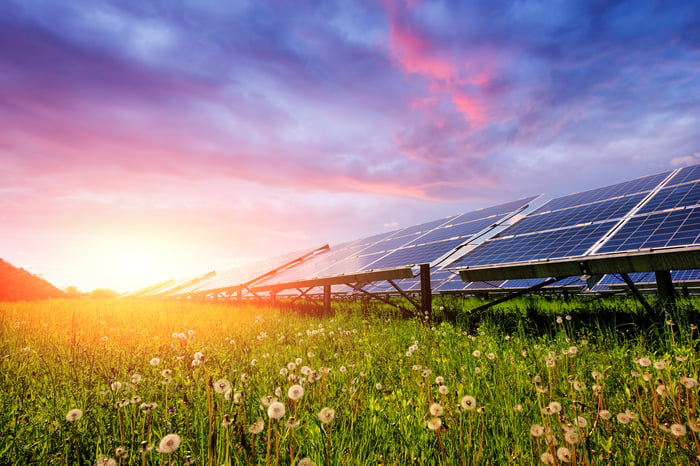When Brookfield Asset Management (BN -0.69%) took control of TerraForm Power (TERP) last year, it aimed to implement a strategy that would slowly turn the struggling renewable power generating company around. However, the plan has unfolded much quicker than expected, which was evident in TerraForm's second-quarter results. Because of that, management was very optimistic about the company's future on the accompanying conference call where they detailed four things that should drive its performance in the coming years.
We've come a long way in a short period
CEO John Stinebaugh started off the call by stating, "Now that we've completed the acquisition of Saeta, TerraForm Power's portfolio stands at over 3,600 megawatts, 40% larger than when Brookfield assumed control of the company late last year." Further, the CEO noted that the company's portfolio has expanded to 12 geographic regions and that it has contracts supporting 95% of the power it will generate, with the average length lasting for 14 years, which will enable it to produce stable cash flow for years to come.

Image source: Getty Images.
In addition to quickly increasing its scale, TerraForm has also made excellent progress on its cost-saving initiatives. The highlight in the quarter was signing an 11-year deal with General Electric (GE 1.99%) to service its wind fleet in North America. As a result of TerraForm's agreement with GE, Stinebaugh noted that "we expect to begin realizing cost savings in the first half of 2019, ahead of our stated goal of phasing in these operational savings over two to three years."
We have a clear path to deliver future growth
The company's accomplishments since joining forces with Brookfield have put it on "a clear path to deliver annual dividend per share growth of 5% to 8% through 2022," according to Stinebaugh, while staying within its target ratio of only paying out 80% to 85% of cash available for distribution (CAFD). Stinebaugh noted that four pillars underpin this outlook:
Cost savings of $25 million in corporate overhead and operations and maintenance, fully achieved on a run-rate basis by the first half of 2018. Revenue improvement of $20 million from increasing the performance of our wind and solar fleets to our long-term average generation targets. Organic investments in our existing fleet and add-on acquisitions to contribute $30 million in CAFD funded by retained cash flow, project level debt and a potential sale of non-core assets, and finally, the accretion from the Saeta acquisition.
With clear line of sight on how it can meet its forecast, TerraForm has removed many of the risk factors that could derail its plan, including eliminating the need to obtain any outside funding to achieve its strategy.
Our balance sheet is much better
A driving factor of the company's ability to self-fund growth is the dramatic improvement of its financial profile. One evidence of this is that "following the closing of the Saeta transaction, Moody's upgraded our corporate credit rating from B1 to Ba3," according to CFO Matthew Berger. That's due in part to the fact that the company decided to issue more equity than initially expected to finance the deal so that it could improve its financial metrics more quickly. That stock, which it sold to Brookfield Asset Management and its affiliate Brookfield Renewable Partners (BEP -2.44%), helped reduce TerraForm Power's corporate debt-to-cash flow ratio toward its 4.0 to 5.0 times target range. That puts the company within striking distance of receiving another credit upgrade to an investment-grade rating, which is TerraForm's goal.

Image source: Getty Images.
We can capitalize on compelling opportunities when they arise
With its balance sheet on much stronger ground and its operations improving at a faster-than-expected pace, TerraForm is in a better position to capture additional opportunities that might occur in the future. The CEO noted that "the transformation of global power grids is still in very early stages and will require hundreds of billions of investment over multiple decades." While that means there should be no shortage of investment possibilities, the company plans to "look for opportunities to deploy capital at attractive rates of return." If it finds good deals, the CEO believes his company is "well positioned to take advantage of the opportunities that will inevitably arise," especially "considering Brookfield's demonstrated willingness to provide support as we pursue investments," according to Stinebaugh.
A two-for-one special
TerraForm Power already had a strong portfolio of wind and solar assets. However, thanks to the help of Brookfield, it has quickly improved the performance of its legacy assets, while adding new ones into the fold. Because of that, the company was recently able to reinstate a high-yielding dividend that it can grow at a high rate for at least the next five years. That growing income stream makes the stock an appealing one to buy these days.





